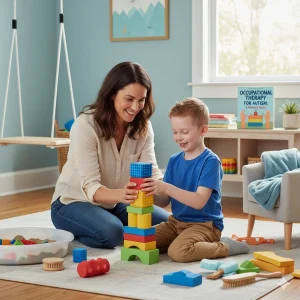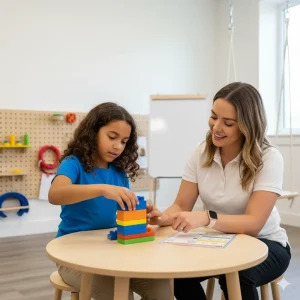How Occupational Therapy Supports Kids with Autism
By Prapoorna M
Last Updated: February 29, 2024
Imagine stepping into a world where sights, sounds, and touches feel overwhelmingly intense. Where simple conversations and social cues seem like a complex code. This world is a daily reality for many individuals with Autism Spectrum Disorder (ASD). Autism is not just a single condition but a spectrum of disorders affecting a person’s social, communication, and behavioral skills. The spectrum nature of ASD means that each person’s experience with autism is unique, with symptoms ranging from mild to severe.
Also Read: History of Autism: Unraveling Autism’s History
The Role of Occupational Therapy in Autism Support
Occupational therapy is like a guiding light in the journey of autism. It’s not just about jobs or occupations, as the name might suggest. Occupational therapists work closely with those on the spectrum to enhance their ability to perform daily activities, from basic self-care tasks to more complex social interactions. This therapy is tailored to each individual’s needs, focusing on their strengths and challenges to help them lead a more fulfilling and independent life.
In essence, occupational therapy doesn’t change who individuals with autism are. Instead, it empowers them to be the best version of themselves, navigating the world with confidence and independence. It’s a journey of small steps, each one taking them closer to a life of greater ease and capability.
Understanding Occupational Therapy for Autism
Decoding Occupational Therapy in the Context of Autism
Have you ever wondered how children with Autism Spectrum Disorder (ASD) navigate their daily challenges? This is where Occupational Therapy (OT) plays a pivotal role. Think of OT as a bridge that connects individuals with autism to a world of greater functionality and independence. But what exactly does this mean in the context of autism?
Occupational therapy is a specialized form of therapy that focuses on helping individuals gain or regain the skills needed for everyday tasks – or ‘occupations.’ For children with ASD, these occupations can range from basic self-care to more complex social interactions. The beauty of OT lies in its holistic approach. It’s not just about improving a single skill but enhancing the overall quality of life for these children.
Why is OT Essential for Children with ASD?
Imagine a toolbox. For most of us, navigating daily life is like using tools from this box almost effortlessly. But for children with autism, some of these tools might seem out of reach. This is where occupational therapy comes into the picture, helping to make these tools accessible and usable.
The significance of OT in the lives of children with ASD is manifold:
- Sensory Integration: Many children with autism experience sensory processing differences. Occupational therapists employ various strategies to help these children manage sensory overload, making the world around them less overwhelming.
- Motor Skills Development: From holding a pencil to tying shoelaces, OT helps in honing fine and gross motor skills, essential for daily independence.
- Social Interaction: Navigating social situations can be challenging for children with ASD. OT provides them with the necessary tools to interact and communicate more effectively.
- Self-Care Skills: Basic tasks like dressing, eating, and grooming are areas where OT can significantly aid in fostering self-reliance.
Also Read: Understanding Autism: The Colours to Avoid for a Harmonious Environment
In essence, occupational therapy for autism is about empowering these young individuals to reach their full potential. It’s about turning ‘I can’t do this’ into ‘Let’s find a way to do this.
Key Benefits of Occupational Therapy
Navigating the Sensory World: Sensory Processing and Integration
For many of us, the world’s sensory stimuli are just background noise. But for children with Autism Spectrum Disorder, these can be overwhelming. Here’s where occupational therapy plays a critical role. OT helps in sensory integration, a process that teaches children with autism how to process and respond to sensory information more effectively. This improvement in sensory processing can significantly reduce feelings of discomfort or distress caused by everyday sensory experiences. It’s like giving these children a map and compass to navigate the sensory complexities of the world.
Mastering Movement: Development of Fine and Gross Motor Skills
Remember the joy of tying your shoelaces for the first time? For children with ASD, mastering such fine motor skills can be a significant achievement. Occupational therapy assists in developing these skills, which are crucial for tasks like writing, buttoning a shirt, or using cutlery. Gross motor skills, on the other hand, involve larger movements like jumping, running, or climbing stairs. OT helps enhance these skills, fostering greater autonomy and confidence in children with autism.
Building Independence: Enhancement of Self-Care and Daily Living Skills
One of the most empowering aspects of occupational therapy is its focus on self-care and daily living skills. These are the skills that allow children with ASD to perform everyday tasks independently, like brushing their teeth, dressing, or eating. By breaking down these activities into manageable steps and practicing them in a supportive environment, OT helps children gain a sense of independence and accomplishment.
Fostering Connections: Social Skills and Communication Improvement
Social interactions can be challenging for children with autism, but they are essential for building relationships and functioning in society. Occupational therapists use a variety of fun and interactive activities to help these children develop social skills. These activities are designed to teach children how to interpret social cues, engage in conversations, and develop friendships. Improving communication skills is also a vital part of this process, enabling children to express their needs and thoughts more clearly.
Sensory Integration and Autism
Understanding Sensory Challenges in Autism
Imagine being in a room where the lights are too bright, the sounds are too loud, and the slightest touch feels overwhelming. For many individuals with Autism Spectrum Disorder (ASD), this is their everyday experience. Sensory challenges are common in autism, where the brain struggles to interpret and respond to sensory information correctly. It can lead to feelings of anxiety, discomfort, or even sensory overload, making everyday environments challenging to navigate.
The Role of Occupational Therapists in Addressing Sensory Challenges
Occupational therapists are like detectives and problem-solvers rolled into one. They work closely with children with autism to understand their unique sensory experiences and develop strategies to help them cope better. The goal is to improve their sensory integration – the process by which the brain organizes and interprets sensory information.
Occupational therapists use a variety of techniques, from sensory diets (customized activities that help regulate sensory input) to specific therapeutic interventions. The aim is to help the child feel more comfortable and engaged in their surroundings, whether it’s at home, school, or in the community.
Also Read: Integrated Yoga Therapy for teaching Toothbrushing skills | Children with ASD
Real-Life Examples of Sensory Integration Techniques
The Use of Sensory Diets:
Imagine a ‘diet’ not for the stomach but for the senses. For a child who is easily overwhelmed by sensory information, an OT might create a sensory diet that includes activities like swinging, deep-pressure exercises with weighted blankets, or tactile play with different textures. These activities are designed to provide the right amount of sensory input to help the child stay calm and focused.
Creating Sensory-Friendly Spaces:
Occupational therapists often work with families to create sensory-friendly environments. This could mean dimming lights, reducing background noise, or setting up a quiet corner with comfort items like soft cushions, which can be a safe retreat when the world gets too overwhelming.
Integrating Sensory Activities into Daily Routines:
For a child who struggles with the textures of certain foods, an OT might introduce a brushing protocol before mealtime to reduce oral sensitivity. Or, a child who is sensitive to touch, might incorporate specific tactile experiences into their daily routine to gradually increase their tolerance.
Occupational Therapy Goals for Children with ASD
Crafting a Path to Independence and Confidence
Occupational therapy for children with Autism Spectrum Disorder (ASD) isn’t just about therapy sessions; it’s about setting goals that pave the way for a more independent and confident life. Each child with ASD is unique, and so are their needs and aspirations. This is why occupational therapists set specific, personalized goals. Let’s explore some of these goals:
1. Fostering Social Participation:
Imagine a world where interacting and playing with others doesn’t feel like a challenge but a joy. For many children with ASD, social participation is a key area of development. OTs aim to enhance these skills by teaching children how to read social cues, engage in cooperative play, and participate in group activities. This could involve role-playing games, social stories, or group sessions to encourage interaction and communication.
2. Building Safety Awareness:
Navigating the world safely is essential. Occupational therapists work on safety awareness, teaching children how to recognize potential hazards and respond appropriately. This includes understanding road safety, awareness of strangers, and learning how to seek help when needed. It’s about giving children the tools to stay safe while exploring their environment.
3. Enhancing Daily Living Skills:
Daily living skills are the building blocks of independence. OTs focus on activities like dressing, eating, grooming, and personal hygiene. Through tailored activities, children learn these vital skills step by step. For instance, an OT might use a picture schedule to guide a child through the steps of brushing their teeth, turning a routine task into an achievable goal.
The Personalized Nature of OT Goals and Interventions
Every child with ASD has their own strengths, challenges, and pace of learning. Occupational therapists at Wellness Hub understand this deeply. They create customized plans that align with each child’s unique needs. This personalized approach ensures that every therapy session is not just a learning experience but also a step toward a child’s individual goals.
For instance, if a child has a passion for drawing, an OT might integrate fine motor skill exercises through art. If a child loves being outdoors, the therapist might incorporate activities like playing catch or navigating a playground to work on gross motor skills and social interaction.
Comparison of Common OT Goals vs. Achievements
| OT Goals | Strategies Employed | Achievements/Improvements |
|---|---|---|
| Sensory Processing | Sensory Integration Therapy, Sensory Diets | Reduced Sensory Overload, Better Tolerance to Stimuli |
| Motor Skills | Fine and Gross Motor Activities, Coordination Exercises | Improved Handwriting, Enhanced Physical Coordination |
| Self-Care | Step-by-Step Skill Breakdown, Routine Establishment | Independence in Dressing, Eating, Personal Hygiene |
| Social Skills | Role-Playing, Social Stories, Group Activities | Better Peer Interaction, Improved Communication Skills |
Integrating Occupational Therapy into Daily Life
Making OT a Part of Everyday Routines
Occupational therapy (OT) for children with Autism Spectrum Disorder (ASD) isn’t confined to the therapist’s office. Its real success lies in integrating these strategies into the child’s daily life. Let’s explore how parents and caregivers can seamlessly incorporate OT practices into everyday routines, reinforcing the skills learned during therapy sessions.
Practical Tips for Reinforcing OT at Home
- Create a Sensory-Friendly Environment: Make your home a comforting space. If your child is sensitive to light, use dimmers or soft-colored curtains. For auditory sensitivities, designate a quiet space where they can retreat when the noise gets overwhelming.
- Routine is Key: Children with ASD often thrive on routine. Establish a consistent daily schedule that includes OT exercises. This could be as simple as a morning stretching routine or a bedtime deep-pressure activity with a weighted blanket.
- Incorporate Play: Make learning fun by turning OT exercises into a game. If your child is working on fine motor skills, activities like building with blocks or arts and crafts can be both enjoyable and therapeutic.
- Involve Them in Daily Tasks: Involve your child in simple household chores like folding laundry or setting the table. These tasks help improve motor skills and promote a sense of responsibility and accomplishment.
Also Read: What are the Tips for Parenting an Autistic Child? | Helping Your Child with Autism
The Importance of Consistency and Routine
Consistency is the cornerstone of effective OT. Regular practice of the skills learned during therapy sessions helps reinforce these behaviors, making them a natural part of the child’s daily life. A routine provides structure, which can be incredibly reassuring for children with ASD, reducing anxiety and helping them understand what to expect from their day.
Exploring Advanced OT Techniques
Advanced Techniques in Occupational Therapy for ASD
Occupational Therapy (OT) is not just about the basics; it also encompasses advanced techniques that cater to the unique needs of children with Autism Spectrum Disorder (ASD). Two such techniques are auditory integration therapy and proprioceptive activities. Let’s dive into how these advanced methods are tailored to individual needs and the benefits they offer.
Auditory Integration Therapy
Auditory Integration Therapy (AIT) is designed for children who experience auditory sensitivities. This technique involves listening to modified sounds or music through headphones, which is intended to help the brain process auditory inputs more effectively.
For a child who is easily overwhelmed by loud noises or certain pitches, AIT can be a game-changer. It can lead to a decrease in auditory sensitivity, making everyday sounds more tolerable and less distressing. Imagine a child who used to cover their ears at the sound of a vacuum cleaner, now being able to stay in the room comfortably – that’s the potential impact of AIT.
Read more on Unlocking Communication: Effective Speech Therapy for Autism
Key Occupational Therapy Techniques and Their Impact
| OT Techniques | Description | Impact on Children with Autism |
|---|---|---|
| Sensory Integration Therapy | Activities to help children process sensory input | Enhanced ability to manage sensory information |
| Auditory Integration Therapy | Listening to modified sounds/music | Reduced auditory sensitivity, improved processing |
| Proprioceptive Activities | Exercises for body awareness and coordination | Improved balance, coordination, and motor planning |
| Play-Based Therapy | Using play for skill development | Enhanced fine and gross motor skills, better social interaction |
| Social Skills Training | Role-playing, social stories | Improved communication, and peer interaction abilities |
Building a Supportive Community
Nurturing a Supportive Environment for Children with Autism
Creating a supportive community is like planting a garden. It requires nurturing, patience, and the collective efforts of many. For children with Autism Spectrum Disorder (ASD), a supportive environment is crucial to their growth and development. It’s not just about providing care but about building a network of understanding, empathy, and collaboration.
Also Read: The Speech Chain: Understanding How We Communicate
Collaboration: The Key to Enhanced OT Effectiveness
Occupational Therapy (OT) thrives in a collaborative environment. When teachers, therapists, other caregivers, and family members work together, the impact of OT is significantly magnified. This teamwork ensures that the child receives consistent support, reinforcing the skills learned in therapy across various settings – be it at home, school, or in the community.
Imagine a scenario where a child practices a certain social skill in OT, and then the same skill is reinforced by teachers in the classroom and parents at home. This consistent approach helps the child internalize and apply these skills more effectively.
Also Read: The Crucial Role of Parents in Online Speech Therapy
Conclusion
Occupational Therapy (OT) aids individuals with Autism Spectrum Disorder (ASD), let’s pause and reflect on the key insights we’ve gathered. OT is not just a therapy; it’s a beacon of hope, guiding children with ASD toward a more manageable and fulfilling life.
Recapitulating the Benefits of OT for Autism:
- Sensory Integration: OT helps in managing sensory overload, making the world a less overwhelming place for children with ASD.
- Motor Skills Development: Fine and gross motor skills are honed, aiding in daily tasks and boosting independence.
- Enhancement of Daily Living Skills: OT empowers children with autism to perform everyday activities with greater ease and confidence.
- Social and Communication Skills: It opens doors to more effective social interactions, helping children build relationships and communicate more effectively.
Wellness Hub: Your Partner in the Journey For families navigating the challenges of ASD, remember, you are not alone. Wellness Hub stands as a resource and a supportive partner in your journey. Our commitment is to provide personalized advice, tailored interventions, and a supportive community to aid the progress of each unique child with autism.
Frequently Asked Questions
1. What is Occupational Therapy for Autism?
Occupational Therapy (OT) for Autism is a therapeutic approach designed to help individuals with Autism Spectrum Disorder (ASD) improve their ability to perform daily activities and interact with their environment effectively. It focuses on enhancing sensory processing, motor skills, social communication, and self-care abilities.
2. How does Occupational Therapy benefit children with Autism?
OT benefits children with Autism by aiding in sensory integration, developing fine and gross motor skills, enhancing daily living skills, and improving social and communication abilities. This leads to improved functioning in everyday life and greater independence.
3. Can Occupational Therapy help with sensory issues in Autism?
Yes, Occupational Therapy is particularly effective in addressing sensory processing issues common in Autism. Therapists use various techniques to help children manage sensory overload and respond more appropriately to sensory stimuli.
4. What are some common Occupational Therapy techniques used for Autism?
Common techniques include sensory integration therapy, fine and gross motor skill activities, social skills training, and daily living skills enhancement. Advanced techniques like auditory integration therapy and proprioceptive activities are also used based on individual needs.
5. Is Occupational Therapy suitable for all children with Autism?
While OT is beneficial for many children with Autism, it’s important to have a personalized approach. The therapy should be tailored to the child’s individual needs, strengths, and challenges for maximum effectiveness.
6. How can parents and caregivers support Occupational Therapy at home?
Parents and caregivers can support OT by creating a sensory-friendly environment at home, maintaining consistent routines, incorporating recommended activities into daily life, and working collaboratively with therapists.
7. Are there any online resources or support groups for parents of children undergoing Occupational Therapy for Autism?
Yes, there are several online resources and support groups available. Wellness Hub offers valuable resources and a supportive community for parents and caregivers of children with Autism, providing guidance and shared experiences.
8. How long does a child with Autism need to undergo Occupational Therapy?
The duration of OT varies for each child with Autism. It depends on the child’s specific needs, goals, and progress. Continuous assessment by therapists helps determine the required length of therapy.
9. Can Occupational Therapy improve social skills in children with Autism?
Yes, OT includes social skills training, which helps children with Autism develop better social interaction and communication skills, aiding in forming relationships and understanding social cues more effectively.
10. Where can I find more information about Occupational Therapy for children with Autism?
For more detailed information about Occupational Therapy for children with Autism, you can visit Wellness Hub’s website at https://www.mywellnesshub.in/, which offers extensive resources, expert insights, and support options.
About the Author:
Prapoorna Mangalampalli
M.Sc., M.A., (Dual Masters in Psychology & English) – Counselor (6+ years of experience)
Prapoorna armed with a passionate dedication fueled by dual Master’s degrees in Psychology and English, Prapoorna sheds light on and elevates human experiences. Over 6+ years of experience fuel her insightful approach to counseling, offering profound empathy and guidance across diverse areas like online, marital, relationship, child, family, and career counseling. This dedication to empowering positive change is further underscored by her specialized training in various counseling sectors.
Currently, at Wellness Hub, she thrives in a team environment that values innovation, compassion, and achieving results for their clients.
Connect with Prapoorna to learn more about how she can help you or your loved one find their voice and build a brighter future.
Book your Free Consultation Today
Parent/Caregiver Info:
Client’s Details:
* Error Message









